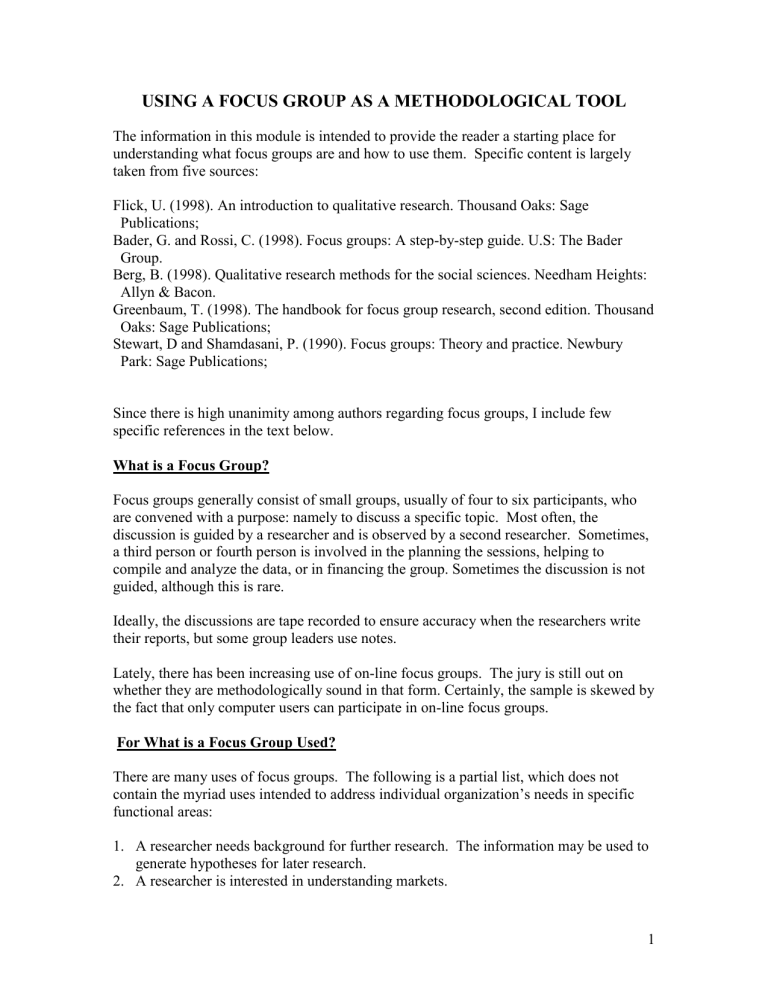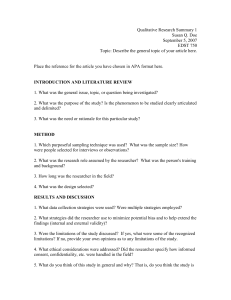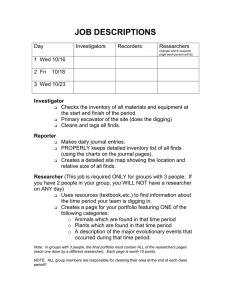USING A FOCUS GROUP AS A METHODOLOGICAL TOOL

USING A FOCUS GROUP AS A METHODOLOGICAL TOOL
The information in this module is intended to provide the reader a starting place for understanding what focus groups are and how to use them. Specific content is largely taken from five sources:
Flick, U. (1998). An introduction to qualitative research. Thousand Oaks: Sage
Publications;
Bader, G. and Rossi, C. (1998). Focus groups: A step-by-step guide. U.S: The Bader
Group.
Berg, B. (1998). Qualitative research methods for the social sciences. Needham Heights:
Allyn & Bacon.
Greenbaum, T. (1998). The handbook for focus group research, second edition. Thousand
Oaks: Sage Publications;
Stewart, D and Shamdasani, P. (1990). Focus groups: Theory and practice. Newbury
Park: Sage Publications;
Since there is high unanimity among authors regarding focus groups, I include few specific references in the text below.
What is a Focus Group?
Focus groups generally consist of small groups, usually of four to six participants, who are convened with a purpose: namely to discuss a specific topic. Most often, the discussion is guided by a researcher and is observed by a second researcher. Sometimes, a third person or fourth person is involved in the planning the sessions, helping to compile and analyze the data, or in financing the group. Sometimes the discussion is not guided, although this is rare.
Ideally, the discussions are tape recorded to ensure accuracy when the researchers write their reports, but some group leaders use notes.
Lately, there has been increasing use of on-line focus groups. The jury is still out on whether they are methodologically sound in that form. Certainly, the sample is skewed by the fact that only computer users can participate in on-line focus groups.
For What is a Focus Group Used?
There are many uses of focus groups. The following is a partial list, which does not contain the myriad uses intended to address individual organization’s needs in specific functional areas:
1.
A researcher needs background for further research. The information may be used to generate hypotheses for later research.
2.
A researcher is interested in understanding markets.
1
3.
A researcher has only one opportunity to gather data and determines that a standardized instrument is not appropriate.
4.
A researcher is interested in the nuances of people’s attitudes or beliefs.
5.
A researcher wants to learn what the common vocabulary is for discussing a topic.
The vocabulary can be useful in the design of questionnaires or other research tools for later research.
6.
An organization wants to gather information in order to redesign programs or diagnose problems.
7.
An organization wants to foment creative approaches to problems.
8. An organization wants to foment the will to change internally.
Why Choose a Focus Group as a Methodological Tool?
This section elaborates on the previous section as well as gives the reader additional information about the choice of a focus group as a tool.
Researchers choose to use focus groups when having a large sample is not necessary and when digging into a topic is advantageous. Focus groups are especially helpful when understanding nuances of attitudes, beliefs, or opinions is a major objective. For this reason, focus groups are popular in market research.
These groups are also very useful when the researcher wants to allow people to use the responses of others as a starting point for their own. In such cases, the researcher is less interested in quantifying responses than in developing responses or stimulating thought among the group’s participants. However, the information derived from the discussions can be used in more quantitative studies at a later time.
Cost is often a factor in the decision to use focus groups. Depending upon the number of people involved in planning and carrying out the research plan, the use of a focus group can be cost-effective. If two researchers, for example, run one or two groups themselves, the cost may be low. If more groups and people are involved, even paid, and training is required to make sure that data is coded corrected by all recorders, the costs may rise considerably.
Carrying Out the Focus Group
While the use of a focus group may not seem like a disciplined approach to data gathering, the opposite actually true. Those who use focus groups must have a specific set of objectives for the group discussion and must have developed a method for cataloging, usually called “coding”, information during the session. A tape recording of a session can be used to clarify points and to provide information for validating the data collected by multiple recorders of information, if necessary.
2
Once the objectives are set, the researcher or team attend to the logistics:
1.
They must decide if an appropriate pool of participants exist and are accessible, and they must develop a plan for inviting them and following up on the invitations. Their plan must include accounting for cultural differences. In some countries, where transportation to the site where the group will be conducted is difficult, another method for data collection may be more appropriate. Also, if strict adherence to time boundaries for the group discussions are not honored, the method may not work.
2.
Choosing participants is not done by random selection but is done to capture information from people who carry the characteristics necessary for a meaningful outcome. Convenience or purposive sampling is appropriate, but the researcher must exercise care to make the group representative of the population of interest.
Homogeneity and heterogeneity are issues. So is the decision regarding how many groups to run. Sometimes researchers stratify their sample into different groups that are homogeneous to facilitate discussions and ask each group then same questions.
3.
The research team must decide whether or not to offer an incentive to participants.
4.
They develop a discussion guide and the instruments for coding the content of the discussion.
5.
They also must train the group facilitators and recorders, so that the data is systematically recorded and the discussion is guided so that it neither gets out of control nor is dominated by one or two participants. During the practice sessions, the intended facilitator or facilitators conduct pretests and build a strategy and practice interventions that keep the discussion within acceptable bounds.
6.
The researchers develop a plan for analysis. Understanding individual data is not the goal. Understanding the macro data or consensus of the group is the goal.
Furthermore, the research team seeks to understand what trends emerged in the discussion and what themes seemed important.
7.
Often, thoughtful researches will use the participants to validate their understanding of the data by, after the data analysis, seeking feedback from some of the group’s members regarding the accuracy of the researcher’s understanding of the content and meaning. Doing so is a validity check: did the discussions actually tap the intended topic?
8.
The researchers can undertake a content analysis of the data. How to do that is carefully explained by Stewart and Shamdasani (1990) and can be adapted by specific researcher for their own groups.
9.
The researchers should consider having participants sign releases, which signal that each is a willing participant and understand the risks of participation. Market researchers often use releases when they have participants test new products. In
IQPs, such releases may not be necessary, but the rationale for not using them should be made explicit in the report.
3
What are the Problem in Using Focus Groups?
1.
The instrument was not sufficiently pretested. The questions should not be pretested on anyone who had anything to do with the development of the research questions.
Pretesting helps to ensure the following:
the wording is uniformly understood,
participants willingly engage in discussion,
the leaders are adequately trained,
2.
Focus groups are sometimes inappropriate for the culture. See point 1 under
“Carrying out the Focus Group.”
3.
A real expert on the topic may be among novice participants, resulting in intimidation of the novices. The researchers briefly should screen participants as they arrive to insure that each is appropriate for the group.
4.
The facilitator introduces bias by exhibiting body language that influences responses.
5.
The sampling frame is not representative of the population under study.
6.
When more than one group is used to explore a topic, facilitators have difficulties in managing the discussion. Thus, the data drawn from both groups might vary in emphasis as well as content, making interpretation difficult.
7.
The facilitator loses control of the discussion.
Below are some websites that as of January 21, 2000 provided useful information about focus groups. Use intellectual skepticism when surfing these web sites. Remember, anyone can put up anything on the web. Use the published books and references. Avoid the sites that seem to be advertisements, themselves, for a product. http://www.useit.com/papers/focusgroups.html
http://www.best.com/~jthom/usability/intrview.htm
4



